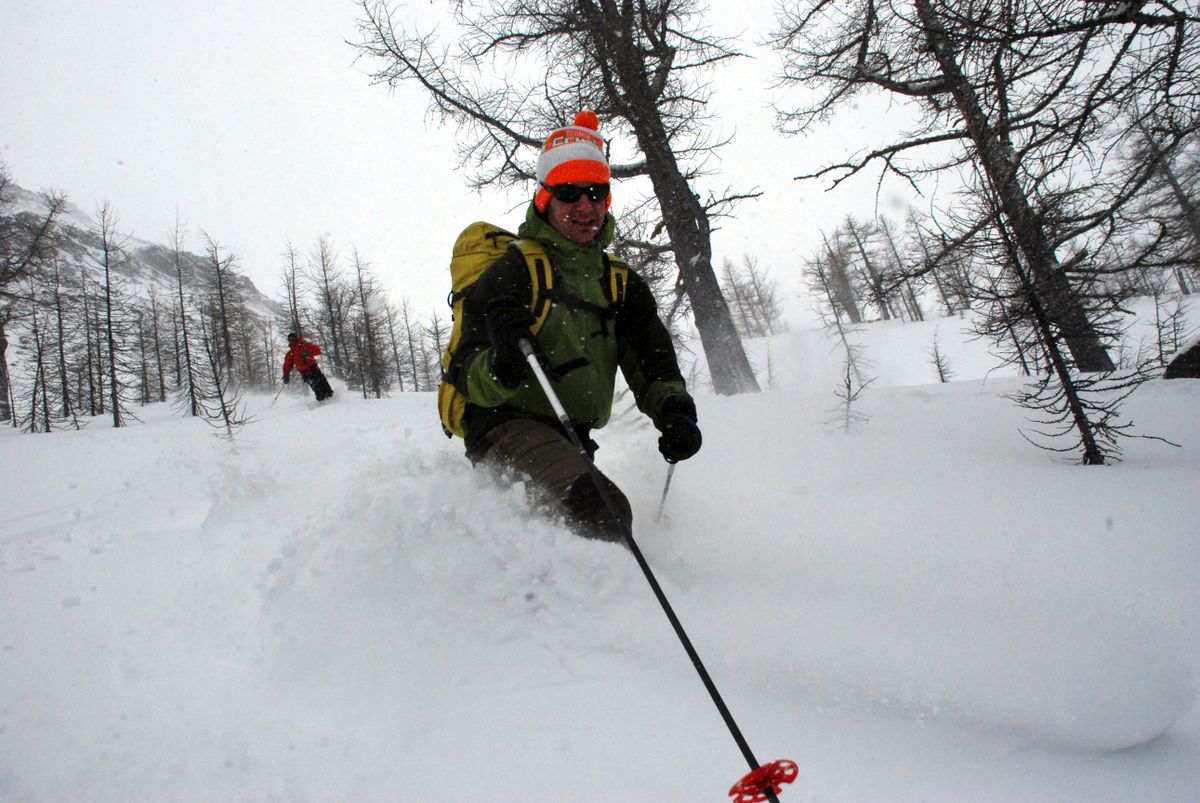Backcountry base for skiers
Purcell Mountains cabin has sheltered powder hounds for 24 years

It’s no accident that backcountry skiers are coming home alive after pillaging the powder in the highest and most remote reaches of British Columbia’s rugged mountains. Nor was it a coincidence that eight skiers were far from a particularly huge naturally triggered avalanche in a Purcell Mountains basin northwest of Kimberley last week, even though they had whooped it up in the same alpine openness on the second day of their weeklong trip.
They had avoided the basin during two subsequent days of snowfall before returning to see that a slide spanning 300 meters had shredded the slopes after the sky had cleared the third day.
“Huge!” said Todd Craig, a veteran guide from Golden, British Columbia, as he surveyed the fracture lines and scoured slopes. “Just what I expected.”
Then he led the group of skiers from the fly-in Boulder Hut facilities to safer slopes and a full day of desecrating virgin powder.
Mountain guides earn their money by staying out of danger, and out of headlines.
“The mountains are dynamic, always changing, you must be learning all the time if you want to make a living up here,” Craig said that night back in the hut.
“The conditions change every year – heck, every month, day, hour,” said Mark Yancey as he pointed out from the cozy cabin to another cold evening of snowfall.
Yancey, a Sandpoint home builder, operates Kimberley-based Boulder Hut/Ptarmigan Tours with his wife, Sarah.
“We offer guided or self-guided, catered or self-catered weeks at the hut,” said Sarah, a ski patrol veteran. “But the small extra price you pay for a backcountry guide is a bargain. You’ll be safer and you’ll find more good places to ski even as conditions change.”
The Association of Canadian Mountain Guides is more serious about training and certification than their American counterparts, said Yancey, a U.S. citizen who lives with his family at Boulder Hut during winter.
“You don’t just take a course and become a top guide,” Craig said. “It takes years to work up through the levels.”
Guests at Boulder Hut, which is accessible only by helicopter during winter, may not even notice that the guides are up an hour before everyone else, getting satellite weather reports and recording temperature and precipitation measurements in the roped-off snow survey plot near the cabin.
During the day, the guides often carve out snow profile pits to closely examine snow stability on the slopes and change their travel plans accordingly.
“This is just one more nugget of information,” said Ken Bélanger, a Canmore-based guide, as he finished digging a 1.5-meter deep snow pit. “It’s not a one-time thing. You accumulate information on the snowpack,” he said, jotting notes and data into his log book. “And even then, safety involves making judgments based on all sorts of factors, not the least of which is your experience in the area.”
In the evening, the guides huddle in a separate cabin to process the latest weather report, assess the ability of the ski group and make a plan for the next day, subject to change, of course.
They make sure each of the clients begins the week with a refresher course in using the avalanche transceiver, shovel and probe everyone is required to carry on excursions during the visit.
And, while breaking trail on uphill routes to help clients keep fresh legs for the downhills, the guides regularly offer subtle reminders on safety.
Craig paused in trees on the uphill march one day and asked if anyone needed to drink water or peel off a layer of clothing. No one in the group responded.
“Well, should we wait until we’re up farther in an open slope?” he said, leaving everyone to realize for himself that it made sense to pause in the safety of the trees so they could move quickly and steadily through upper areas more exposed to avalanche.
Bélanger sometimes employed his probe to check for snow depth, layer changes and rocks.
The guides set boundaries for every run so no skier would venture out into more dangerous terrain that might imperil themselves or the rest of the group.
Yancey emphasized the buddy system when skiing the glorious powder through trees and glades.
Bélanger often paused and reminded skiers to separate by 10-20 meters before they trekked across open slopes. “Just practicing good habits,” he said.
“These are practices all (winter travel) groups should follow, guided or unguided,” Yancey said. “But that’s not always the case.”
Indeed, a knowledgeable guide can make lemonade from virtually any lemon the winter mountains serves up.
“Facet is the weak layer of granular ice that makes mountain snowpacks unstable and susceptible to avalanche,” Craig said with a solemn face that grew to a smile.
“But it makes great margaritas.”